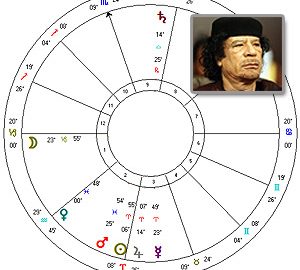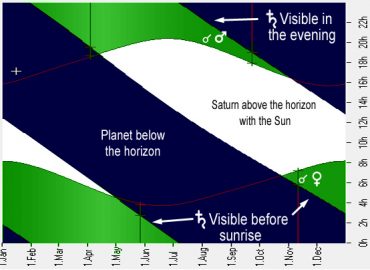Bernadette Brady
September 2006
We are currently in an eclipse season, that is to say that within this period, late August to early October as the transiting sun moves to within 190 of the transiting node, there will be eclipses on some of the full and new moons within this period.
The Babylonian astronomers/astrologers were the first to calculate the regular intervals at which eclipses occurred when they discovered what we now know as the Saros Cycle of eclipses. These great cycles produce eclipses in sets. A set will consist of all solar or all lunar eclipses with each successive eclipse occurring every 18 years and 9-to-11 days. One whole cycle will consist of a collection of 70 – 72 eclipses which then unfold over a period of about 1260 to 1300 years. By the 8th century B.C.E. the Babylonians had understood these cycles and were therefore able to predict eclipses.
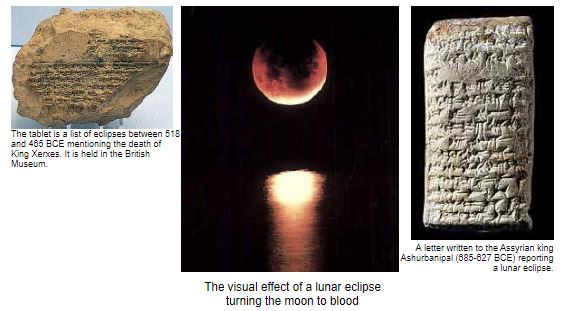
A Lunar eclipse is visibly more frequently than a solar eclipses and within a lunar calendar culture where the new and full moons needed to be observed every month, the sight of the full moon turning to blood was a closely watched and described phenomena. From their writings we can see, however, that the Babylonians did not always consider an eclipse to be portents of evil or disorder.
Since the Babylonians functioned using a lunar calendar, the 28th – 30th day of the month was always the new moon, and the 14th – 15th day of the month was the full moon. Therefore all solar eclipses must logically occur around the 28th to 30th days of the month (on the new moons) and all lunar eclipse must occur on the 14th or 15th days of the month (full moon). If an eclipse was seen to happen at any other time, this became a sign of great evil, for it meant that the annual rhythm of the sun and the moon was lost or, more importantly, that the calendar was incorrect.
For example, around 650 B.C.E. the priest Akkullanu (Hunger:63) warned of what could happen if an eclipse, solar or lunar, occurred on the 21st Tishri (in the modern calendar this would be 21 days after the new moon in September).
[If] (the moon) makes an eclipse [in
T]ishri (VII) on the 21st day and sets
eclipsed: [they will take] the crowned king
from [his palace] in fetters.
Such an eclipse indicated serious problems with the order of the universe and so the correct action to take was to remove the king from the palace in fetters, as it was his responsibility to maintain the order of the known world. However, if an eclipse occurred on the correct day of the month, then order was maintained. Nevertheless such an eclipse could be considered as either difficult or fortuitous. An eclipse in May/June or September/October was generally viewed as difficult (Hunger:63):
[If the moon makes an eclipse [in Tishri
(VII)] from the 1st to the 30th day: fall [of an
army ……]. will capture its people; if you
perform (the observation) for the well-being
of [the king, the city, and its people: well-
being; ……] floods [……].
An eclipse which occurred at the beginning of the year – March/April – was thought to be auspicious. Consider this letter from Nabu-iqisa (ca 650 B.C.E.) on reporting a lunar eclipse to the king (Hunger:163):
At the beginning of the year an eclipse
was seen ……: on the 14th day (the moon)
was seen with the sun. This is good for the
king my lord.
Nevertheless any interference with the face of the full moon, such as its darkening by an eclipse or even clouds crossing its face, was taken as threatening, for the Moon god, Sin, was meant to see the Sun (the king) every month in order for the king to be blessed and for the order of the kingdom to continue.
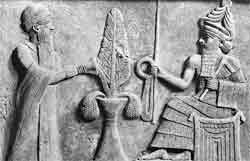
B.C.E. shows Ur-Nammu, the first king of the third dynasty of Ur, making a sacrifice before Sin.
However, we can see from the text of Nabu-iqisa that they could be regarded as positive and that it depended on the eclipse’s location, its timing and whether other planets were in favourable positions. When visual astrology moved into the Hellenistic model and eclipses were simplified they then seemed to lose their “shades of grey”, as they were all considered as evil portents and generally delineated to imply the death of a king. This was effectively a migration into the Hellenistic world of the of the Babylonian religious belief of the Moon god, Sin bestowing earthly power to the king. Furthermore, we see this religious idea of the power of the Moon god, Sin, moving into Christianity and reinforced in the historical reference of an eclipse at the time of the crucifixion of Christ.
The Crucifixion
Just as the gospels refer to the sky when they talk of the birth of Christ with the Star of Bethlehem, there are also three gospels which discuss the sky at the time of the crucifixion:
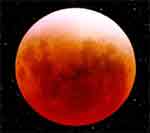
Matthew 27:45 :Now from the sixth hour there was darkness over all the land unto the ninth hour.
Mark 15:33: And when the sixth hour was come, there was darkness over the whole land until the ninth hour.
Luke 23:44-48: And it was about the sixth hour, and there was a darkness over all the earth until the ninth hour. And the sun was darkened, and the veil of the temple was rent in the midst.
However, it may be unwise to assume that the gospels of Matthew, Mark and Luke were faithful to the actual sky events of the day, for given the link with eclipses and the death of kings, the authors of the gospels may have been more concerned with enhancing Christ’s position as king by suggesting that an eclipse took place when he died. For there was, at that time, a tradition of announcing the birth time of Roman Emperors as either dawn or midday which placed their natal suns either rising or culminating, thereby implying a solar king’s title. So it is logical to suggest that the claim to kingship would carry more weight in the early days of Christianity if Christ’s mortal death occurred on an eclipse.
A period of darkness for three hours is well beyond the timing of a solar eclipse and therefore some believe that this sky event was actually a lunar eclipse. In June, 2004, two Romanian astronomers, Liviu Mircea and Tiberiu Oproiu, from the Astronomic Observatory Institute in Cluj, Romania, announced that they had dated the crucifixion from the lunar eclipse on 3 April, 33 C.E. , visible in Jerusalem around sunset, indicating that the moon would have risen blood red on that Friday evening in Jerusalem.
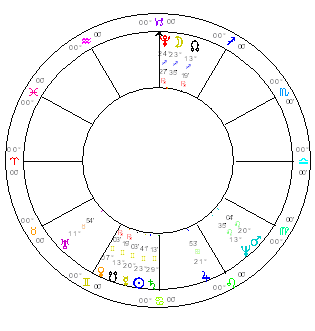
Eclipses in 20th and 21st century western astrology
In present time we once again regard eclipses as varying in their expression and although we no longer judge them via the Babylonian method of visual astrology, we can gauge eclipses based on the Saros series to which they belong (Jansky, 1979; Brady, 1992).
For example the Lunar eclipse on 7 September , 2006
which will occur at 150 Pisces belongs to a series ( van den Bergh 118). [There are different ways of naming Saros Series and astronomers use G. van den Bergh (1954) method and astrologers tend to use the method employed by Robert Jansky (1977)]. This series was first visible as a lunar eclipses on 8 June, 1267, at 7.32 GMT
(This charthas a 0 Aries chart and thus the houses have no meaning).
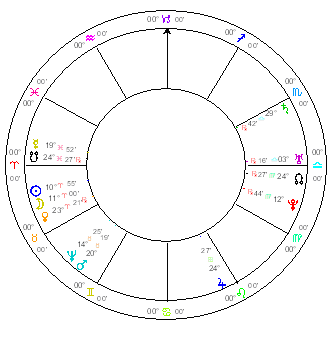
At the time of this lunar eclipse there was a Moon/Pluto combination in opposition to a Sun/Saturn conjunction. Thus this family of lunar eclipses has a difficult expression of emotional intensity clashing with authority or the authority of the written word.
So people or countries with sensitive natal points at 15 mutable (Gemini, Virgo, Sagittarius or Pisces) will experience this intense eclipse.
The Solar Eclipse on 22 September, 2006, which will occur at 290 Virgo belongs to Saros Series 8 South (Jansky method of naming).
This solar eclipse belongs to a series which commenced 1 April, 1718, at 0:15:02 GMT (chart right) and will be active until 30 April, 2962. The first eclipse in this series contained Saturn forming an exact opposition to the short arc midpoint between the solar eclipse and Mars. I delineated this combination as: Separation and loss. To be parted. To finish something, and to feel sad at its completion. Physical injury is also possible through over-straining one’s strength. (Brady:1992:319)
So this eclipse suggests that people and/or countries that have a sensitive natal point at 290 mutable (Gemini, Virgo, Sagittarius or Pisces) will have to end something, complete a hard process or let go of something.
It is therefore a difficult eclipse season and a Babylonian approach was to use a substitute king, an individual who was killed in order that the prophecy of the difficult eclipse was fulfilled. If your chart is being influenced by this season of eclipses, then you may be able to use a more gentler version of this ancient method by deciding to let go of something of your choice, something that needs to leave your life naturally, so at least you are more in control of selecting the nature of the parting indicated.
Further information:
Another Visual Astrology Newsletter that looks at Lunar eclipses is October,2005 – The Moon Sets with Unwashed Feet.
With regards to the Star of Bethlehem see the December, 2005 edition of the Visual Astrology Newsletter –
The Star of Bethlehem, shepherds, a manger and those kings…
Sources:
Brady, Bernadette.(1992). Predictive Astrology, the Eagle and the Lark. Samuel Weisers: York Beach, Maine.
Hunger, Herman. (1992). Astrological Reports to Assyrian Kings. Helsinki, Finland: Helsinki University Press.
Jansky, Robert, Carl. (1977). Interpreting the Eclipses. San Diego, California: Astro Computing Services.


